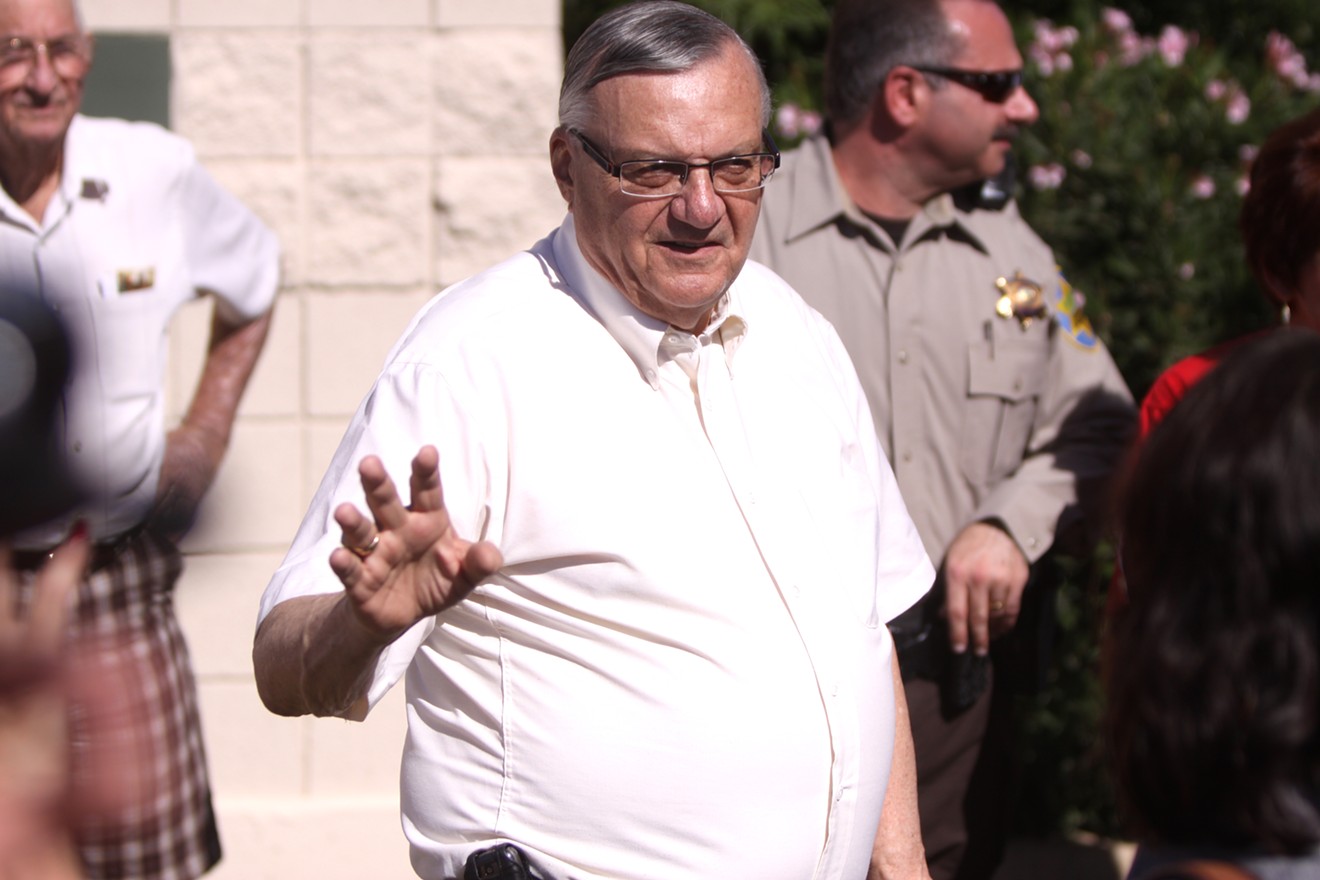The checkered history of the volunteer "posses" who work with the Maricopa County Sheriff’s Office, bearing arms and departmental insignia, will soon be under the magnifying glass.
The posses are going under review, according to an announcement from Sheriff Paul Penzone on Friday. The Executive Advisory Review Committee, also known as SPEAR, said that they will examine how the posses function currently and what needs to change, per a decision from Penzone.
Penzone created the advisory board as a part of his departmental overhaul since taking office in January. One of his first actions was dismantling the so-called Cold Case Posse that aided former Sheriff Joe Arpaio's birther conspiracy mania in 2011.
Grant Woods, the chair of SPEAR and a former Arizona attorney general, said simply, "It's the sheriff's decision."
"He’s definitely committed to the idea of the posse — that he knows that it’s done a lot of good in a lot of different areas — and so that’s fine," Woods told Phoenix New Times. "However, I think there are a lot of questions about how it’s organized, who’s in it, what they do and don’t do."
Posse members are unpaid volunteers who must undergo a background check before they join the sheriff's office; however, they are not trained or certified officers per the standards of the Arizona Peace Office Standards and Training Board. They wear badges and patches. Some carry guns. Some drive MCSO vehicles. And under Arpaio, they were given wide latitude to make arrests and work alongside sworn deputies.
Wood mentioned that even the name "posse" raises eyebrows.
"The bottom line is, it’s not 1897," he said. "It’s 2017, so we just need to make sure this thing is being operated in the correct way."
The following are a few notable, or jaw-dropping, moments in the history of the posses which might have prompted the renewed scrutiny.
1. Posse members participated in Arpaio's immigration sweeps that targeted and terrorized Latino communities in Maricopa County — a factor in the federal court order that smacked down his department for racial profiling. In 2010, Arpaio created the "illegal immigration operations posse," and trumpeted the support of actors Steven Seagal and Lou Ferrigno, best known as the actor who played the Incredible Hulk.
In a statement of interest in Melendres v. Arpaio, the civil rights case against the MCSO, the U.S. Department of Justice described the department's mind-boggling decision to use untrained volunteers in various capacities, including as enforcers of immigration law. Posse members identified and searched vehicles, transported people suspected of violating immigration law, helped execute worksite raids, and provided crowd control during demonstrations against MCSO immigration policies.
"MCSO provides insufficient supervision and oversight to ensure that volunteer posse members taking part in immigration enforcement activities do so without engaging in unlawful discrimination," the DOJ wrote.
2. After the massacre at Sandy Hook Elementary School in Newtown, Connecticut, Arpaio sent posse members on patrol at local elementary schools — never mind the fact that posse members are not certified peace officers per the standards of the state board governing law enforcement. New Times rode along with one posse member in 2013:
"The one-time Detroit cop explains that he'd rather be in Arpaio's posse. In this case, that involves driving about 15 mph around Diamond Canyon Elementary School, and through all the dead-silent residential streets that provide access to the school's property. That's his definition of a 'hobby,' he explains."
3. A commander of Arpaio's Executive Posse and a former chairman of the Maricopa County Republican Party owned a warehouse that, unbeknownst to him, was a lynchpin in a marijuana-smuggling network. According to federal court records, in 1997 officers found a marijuana processing center in one section of Marvin Weide's warehouse that was capable of processing thousands of pounds of the drug.
Weide denied any knowledge of the activities in the warehouse, despite using the warehouse for his auto-parts business. As it happens, Weide and other posse members made campaign signs for Arpaio's re-election in the fall of 1996 in another section of the same warehouse.
4. Posse members were instrumental in Arpaio's racist birther conspiracy, and "investigated" former President Barack Obama's birth certificate in 2011. The so-called "Cold Case Posse" peddled lies and demonstrably false "evidence" about Obama's birthplace, all the while functioning as a nonprofit. At one point, the Cold Case Posse was nearly dissolved for filing a fake address with the state in an attempt to hide its real address from the public.
5. You'll have to read this one yourself to believe it. A bizarre feature story in Atavist magazine chronicles two characters, both aspiring law enforcement officers, named Christopher Dancel and Steve Farzam.
According to the piece, Dancel would drive six hours east from California to Maricopa County in order to participate with the volunteer posse force of the sheriff’s office. In the fall of 2014, he “was terminated from the posse” after ranting on a phone call to the posse leadership. If anything, the story is more evidence that Arpaio's posses were not exactly attracting the best and the brightest.
6. Posse membership dwindled as Arpaio's career came to an end. In July 2015, an MCSO spokesperson told New Times that there were 986 current posse members, in contrast to a purported head count of 3,000 members not too long before.
Lisa Allen said that the racial profiling and bias training imposed on the posse as a result of the 2013 civil rights ruling in Melendres was a factor in the decline. “Many were not willing to do the training either because they did not have the time or interest or they did not agree with the ruling,” Allen told New Times at the time.
7. Brian Sands, an Arpaio associate, wrote in a 2012 book that Arpaio ostensibly liked the posses because of some sense of nostalgia. But in reality, the posses were a media stunt and political tool designed to buttress a racist agenda.
Sands resigned as MCSO deputy chief shortly after Arpaio lost the Melendres class action lawsuit.
Although Arpaio claimed he supported the posses because he liked Gene Autry movies, "I came to understand the underlying reason was political," Sands wrote in Arpaio: De Facto Lawman.
The posses, Sands explained, were a media ploy designed to show that the department was saving taxpayer dollars by enlisting volunteers. The posses also magnified Arpaio's support, seeming to show volunteers serving their sheriff's goals in their spare time, and amplifying his message through a network of loyal supporters.
[
{
"name": "Air - MediumRectangle - Inline Content - Mobile Display Size",
"component": "18478561",
"insertPoint": "2",
"requiredCountToDisplay": "2"
},{
"name": "Editor Picks",
"component": "16759093",
"insertPoint": "4",
"requiredCountToDisplay": "1"
},{
"name": "Inline Links",
"component": "17980324",
"insertPoint": "8th",
"startingPoint": 8,
"requiredCountToDisplay": "7",
"maxInsertions": 25
},{
"name": "Air - MediumRectangle - Combo - Inline Content",
"component": "16759092",
"insertPoint": "8th",
"startingPoint": 8,
"requiredCountToDisplay": "7",
"maxInsertions": 25
},{
"name": "Inline Links",
"component": "17980324",
"insertPoint": "8th",
"startingPoint": 12,
"requiredCountToDisplay": "11",
"maxInsertions": 24
},{
"name": "Air - Leaderboard Tower - Combo - Inline Content",
"component": "16759094",
"insertPoint": "8th",
"startingPoint": 12,
"requiredCountToDisplay": "11",
"maxInsertions": 24
}
]












